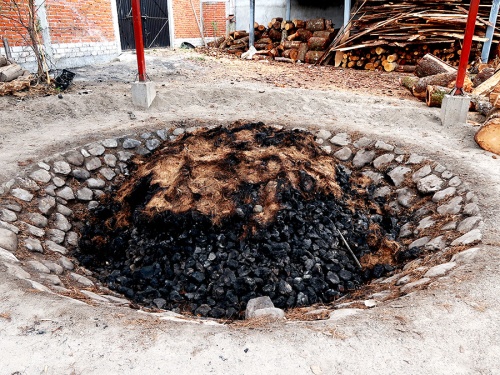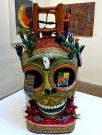On day 2 of introducing B to the sights, sounds, and flavors of Oaxaca, I turned to the professionals at Discover Oaxaca for assistance. I had met the owners Suzanne Barbezat (author of Frida At Home) and her Oaxaqueño husband, Benito Hernández, several years ago through friends and knew they were licensed guides. And, as coincidence would have it, they were good friends of B’s god-daughter and her Oaxaquaño husband in California. The choice was easy and the rave reviews on TripAdvisor were icing on the cake.
Thus, Wednesday began with Benito picking us up in a comfortable, spacious, and air-conditioned van. Our day’s first destination was Mitla, the second most important archeological site in Oaxaca and home to amazingly intricate grecas (fretwork). However, as we headed east on Mexican highway 190, Benito was a fountain of knowledge — much of which was new to me. This was going to be good!

Grecas (fretwork)on the outside of the Palace at the archaeological site at Mitla.
For almost an hour and a half, Benito led us through the site — always explaining, answering our questions, and letting us marvel at what was before us. We could have stayed for at least another hour, but we headed back west on 190, to Yagul, an archeological site I had previously never visited. Several friends told me they experienced a deeply spiritual sense and that it was a must see. We barely skimmed the surface (definitely a place to return to), but the sun was hot, archeological overload was setting in, and hunger beckoned.

Ballcourt at Yagul — the biggest in the valley of Oaxaca.
Next stop, Restaurante Tlamanalli in Teotitlán del Valle — the renown restaurant of Zapotec cooks, Abigail Mendoza and her sisters. Using time honored methods and recipes refined over generations, the Mendoza sisters have elevated and brought worldwide recognition and respect for their traditional cuisine. It was a delicious and tranquil interlude.

Metates used at Restaurante Tlamanalli to grind ingredients for mole and more.
Tearing ourselves away, Benito, B, and I climbed back into the van and drove to the center of the village to see Templo de la Preciosa Sangre de Cristo, another of the countless churches throughout Mexico built on top of a sacred indigenous site.

Templo de la Preciosa Sangre de Cristo, sits atop Zapotec ruins at the base of Picacho, the sacred mountain in Teotitlán del Valle.
My intent, during our visit to this village, known for its weaving with wool, had been to visit several of the weavers I know — including Fidel Cruz Lazo, Antonio Ruiz Gonzalez, his brother Sergio Ruiz Gonzalez, and the family of Samuel Bautista Lazo. However, we were running short of time, and B had been following my adventures with the family of Juana and Porfirio Gutierrez Contreras and had poured over the family’s website, so stopping at their home and workshop was a priority for him. Porfirio was back in the USA, but Juana and her husband Antoño gave their always excellent explanation and demonstration of their work with natural dyes. And, yes, B couldn’t resist purchasing a wonderful rug (though not the one pictured below)!

Woven wool tapete (rug) by Porfirio Gutiérrez Contreras.
On the way back to Oaxaca city, our last stop for the day was at Santa María del Tule to see the world famous Árbol del Tule. This Montezuma cypress (Taxodium mucronatum; Ahuehuete in Nahuatl) has the largest trunk of any tree in the world, is thought to be between 1,200 and 3,000 years old, and is home to hundreds, if not thousands, of birds. It is quite a sight to hear, let alone see.

Looking up at the Árbol de Tule in Santa María del Tule, Oaxaca.
We left Oaxaca city at 9:15 AM and didn’t return until almost 6:00 PM. It was a full, informative, and terrific day. Next up, day 3 — another delightful day out of the city with Benito.
Save
Read Full Post »




















































































































 Mexican Peso Converter
Mexican Peso Converter